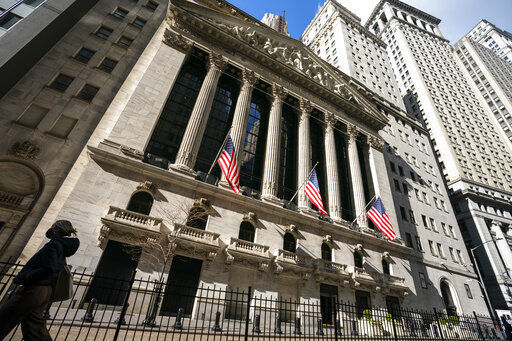NEW YORK — Wall Street is tumbling even more today, sending the S&P 500 down more than 20% from its record, amid fears that a recession is more likely given how unshakeable inflation has become.
The S&P 500 was 2.7% lower in the first trading after investors had the weekend to reflect about a stunning report that showed inflation is getting worse, not better as some had hoped. The Dow Jones Industrial Average was down 625 points, or 2%, at 30,767, as of 8:40 a.m. Central time, and the Nasdaq composite was 3% lower.
The center of Wall Street’s focus was again on the Federal Reserve, which is scrambling to get inflation under control. Its main way to do that is to raise interest rates in order to slow the overall economy, a blunt tool that carries the risk of causing a recession if used too aggressively.
Speculation is building that the Fed later this week may raise its key short-term interest rate by three-quarters of a percentage point. That’s triple the usual amount and something the Fed hasn’t done since 1994. Traders now see a 42% probability of such a mega-hike, up from just 3% a week ago, according to CME Group.
No one thinks the Fed will stop there, with markets bracing for a continued series of bigger-than-usual hikes. Those would come on top of some already discouraging signals about the economy and corporate profits, including a record-low preliminary reading on consumer sentiment that was soured by high gasoline prices.
It’s all a whiplash turnaround from earlier in the pandemic, when central banks worldwide slashed rates to record lows and made other moves that propped up prices for stocks in hopes of juicing the economy.
Such expectations are also sending U.S. bond yields to their highest levels in years. The two-year Treasury yield shot to 3.20% from 3.06% late Friday, its second straight major move higher. It’s more than quadrupled this year and touched its highest level since 2008.
The 10-year yield jumped to 3.27% from 3.15%, and the higher level will make mortgages and many other kinds of loans for households and for businesses more expensive.
The gap between the two-year and 10-year yields is also narrowing, a signal of increased pessimism in the bond market. If the two-year yield tops the 10-year yield, some investors see it as a sign of a looming recession.
The pain was worldwide as investors braced for more aggressive moves from a coterie of central banks.
In Asia, indexes fell at least 3% in Seoul, Tokyo and Hong Kong. Stocks there were also hurt by worries about COVID-19 infections in China, which could push authorities to resume tough, business-slowing restrictions.
In Europe, Germany’s DAX lost 2.2%, and the French CAC 40 fell 2.3%. The FTSE 100 in London dropped 1.3%.
Some of the biggest hits came for cryptocurrencies, which soared early in the pandemic when record-low interest rates encouraged investors to bid up the riskiest investments. Bitcoin tumbled more than 14% and dropped below $23,400, according to Coindesk. It’s back to where it was in late 2020 and down from a peak of $68,990 late last year.
On Wall Street, the S&P 500 was 20.9% below its record set early this year. If it finishes the day more than 20% that high, it would officially enter what investors call a bear market.
The last bear market wasn’t that long ago, in 2020, but it was an unusually short one that lasted only about a month.
This would also be the first bear market for many novice investors who got into stock trading for the first time after the pandemic, a period when stocks largely seemed to go only up. That is, they did until inflation showed that it was worse than just a “transitory” problem as initially portrayed.


